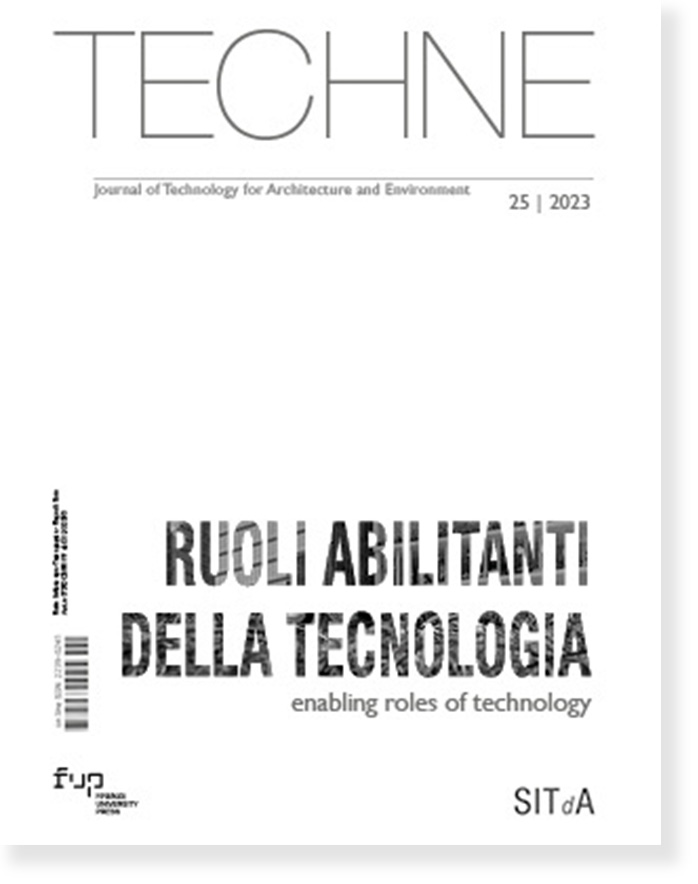Published 2023-05-30
Keywords
- Smart Heritage,
- Liminal spaces,
- Smart sensor systems,
- eHeritage,
- Heritage-plus
How to Cite
Copyright (c) 2023 Marta Calzolari, Valentina Frighi, Valentina Modugno

This work is licensed under a Creative Commons Attribution 4.0 International License.
Funding data
-
Ministero dell'Università e della Ricerca
Grant numbers F71F19000540001
Abstract
The current and increasingly intensive technocratic drift recognises the indiscriminate power of techniques in solving several problems, including the struggle against climate change and its impact on cities. One of the future challenges concerns the effective and conscious application of KETs for the creation of smart environments in historical heritage, which plays a strategic role for its conservative values, but also in the broader strategy for limiting greenhouse gas emissions. The proposed paper reports some preliminary results of a research aimed at investigating and acknowledging these technologies as an enabling medium to undertake more informed deterministic choices in the field of CH.
Downloads
References
Catalina T., Iordache V. and Caracaleanu B. (2013), “Multiple regression model for fast prediction of the heating energy demand,” Energy and Buildings, vol. 57, pp. 302–312 available at: https://doi.org/10.1016/j.enbuild.2012.11.010 (Accessed on 01/09/2022)
COM (2009), “Preparing for our future: Developing a common strategy for key anblign technologies in the EU”, available at: https://eur-lex.europa.eu/LexUriServ/LexUriServ.do?uri=COM:2009:0512:FIN:EN:PDF (Accessed on /08/2022)
Dawn, S. and Biswas, P. (2019), “Technologies and Methods for 3D Reconstruction in Archaeology” In: Thampi, S. et al. (eds) Advances in Signal Processing and Intelligent Recognition Systems SIRS 2018. Communications in Computer and Information Science, vol 968. Springer, Singapore.
IATE - European Union terminology (2018), Smart Environment, available at: https://iate.europa.eu/entry/result/3579068/en (Accessed on 02/09/2022)
Galatioto A., Ciulla G. and Ricciu R. (2017), “An overview of energy retrofit actions feasibility on Italian historical buildings,” Energy, vol. 137, no. 2017, pp. 991–1000, available at: https://doi.org/10.1016/j.energy.2016.12.103 (Accessed on 18/07/2022)
Hajjaji Y., Boulila W., Farah I. R., Romdhani I. and Hussain A. (2021), “Big data and IoT-based applications in smart environments: A systematic review”, Computer Science Review, Volume 39, February 2021, available at: https://doi.org/10.1016/j.cosrev.2020.100318 (Accessed on 07/07/2022)
Hansen T.K., Bjarløv S.P., Peuhkuri R.H. and Harrestrup M. (2018), “Long term in situ measurements of hygrothermal conditions at critical points in four cases of internally insulated historic solid masonry walls”, Energy and Buildings 172 (2018) 235–248, available at: https://doi.org/10.1016/j.enbuild.2018.05.001 (Accessed on 04/08/2022)
Huang W., Xiang H. and Li S., “The application of augmented reality and unity 3D in interaction with intangible cultural heritage,” Evolutionary Intelligence, 2019, available at: https://doi.org/10.1007/s12065-019-00314-6 (Accessed on 04/08/2022)
Hunter G.W., Stetter J.R., Hesketh P.J. and Liu C. (2010), “Smart Sensor Systems”, The Electrochemical Society Interface, pp. 29-34, available at: https://www.electrochem.org/dl/interface/wtr/wtr10/wtr10_p029-034.pdf (Accessed on 04/01/2022)
Lucchi E., Dias Pereira L., Adreotti A., Malaguti R., Cennamo D., Calzolari M. and Frighi V. (2019), “Development of a Compatible, Low Cost and High Accurate Conservation Remote Sensing Technology for the Hygrothermal Assessment of Historic Walls”, Electronics 2019, 8, 643 available at: https://doi.org/10.3390/electronics8060643 (Accessed on 02/09/2022)
Mussinelli E., Schiaffonati F. and Torricelli M.C. (2022), “Per un cambiamento necessario”, TECHNE – Journal of Technology of Architecture, n.23/2022, Firenze University Press, Firenze, available at: https://doi.org/10.36253/techne-12915 (Accessed on 02/09/2022)
Paris S. (2021), “Progetto e tecnologie, tra scienze e nuovo umanesimo. Innovazioni nella formazione e ruolo dei progettisti”, TECHNE – Journal of Technology of Architecture, n.21/2021, Firenze University Press, Firenze, available at: https://doi.org/10.13128/techne-9939 (Accessed on 02/09/2022)
Politecnico di Milano, “INTERNET of THINGS (IoT)
Significato, esempi, ambiti applicativi e prospettive di mercato in Italia”, available at: https://blog.osservatori.net/it_it/cos-e-internet-of-things (Accessed on 31/08/2022)
Posey B. (2021), “Smart sensor”, in Internet of things agenda on Tech Target, available at: https://internetofthingsagenda.techtarget.com/definition/smart-sensor (Accessed on 04/01/2022)
UNESCO, 2019-2020 World Heritage map, available at: http://whc.unesco.org/en/wallmap/ (Accessed on 31/08/2022)






